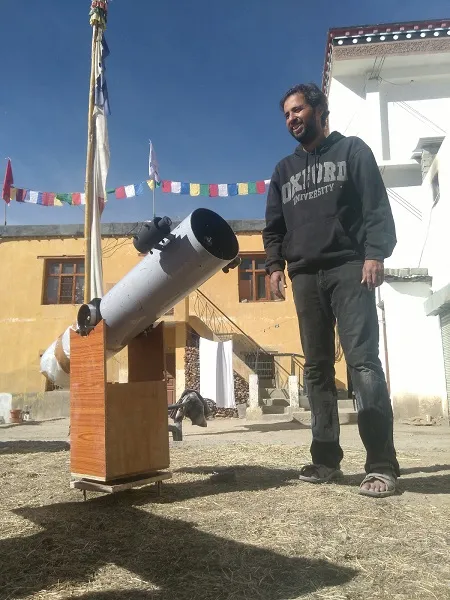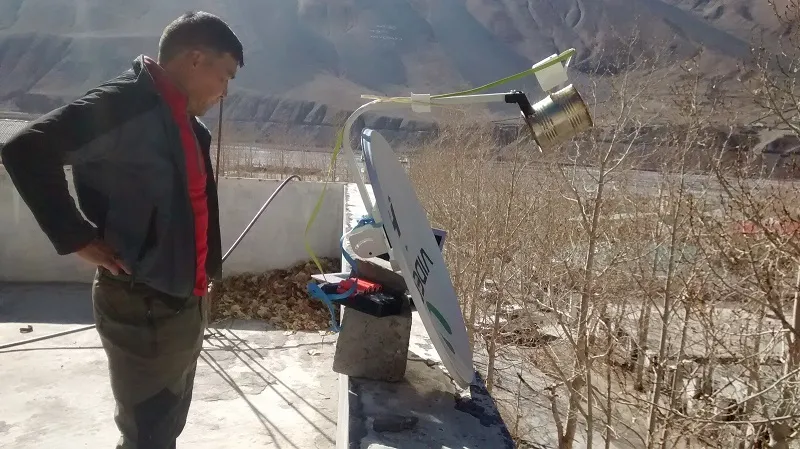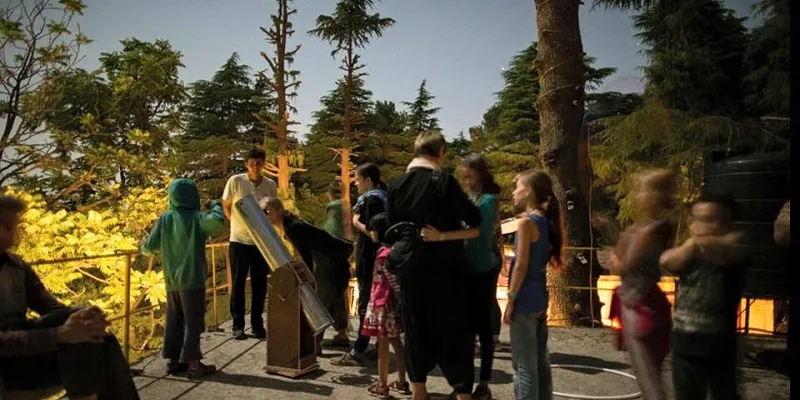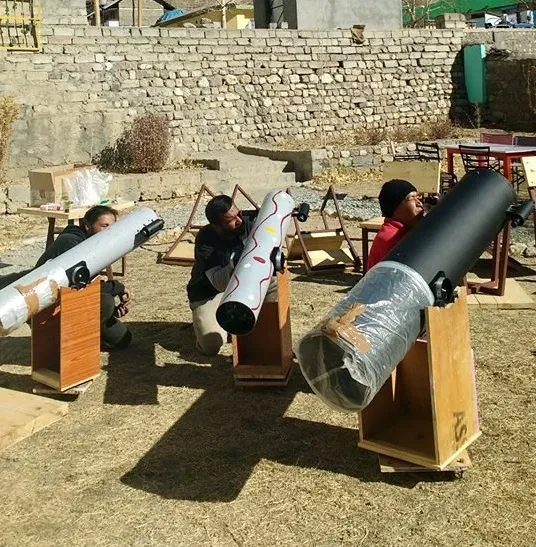In search of the meaning of life at 4,000m through Wi-Fi links and telescopes
"Are science and spirituality linked in some way," asked Karan, aka the Himalayan Shepherd who runs Hotel Deyzor along with a bunch of local travel and conservation initiatives in the mountain town of Kaza in Spiti, Himachal Pradesh. The person on the other side of the table is Anish Mangal, another traveller of life and lover of mountains who had just arrived in Spiti to help set up telescopes and schoolservers in Spiti. Accompanying him is Sohail Lalani, who is a web developer and photographer. This question often pops up and has been a topic of intense discussions in the recent past. From books like The Tao of Physics or Zen and the Art of Motorcycle Maintenance, to conferences between scientists and monks, a lot of us are currently interested in exploring this beautiful mystic intersection. The answer probably lay somewhere deep, deep within us, but the questions make for some interesting conversations.

This story is about Anish’s quest with learning, telescopes and mountains. An Electronics and Communication engineer by training, Anish joined Freescale Semiconductor (erstwhile Motorola) but quickly grew out of it to explore other interests. “I started looking for opportunities where I could contribute in the areas of my interest. I heard of the One Laptop Per Child (OLPC) project (launched by MIT Media Labs), and got immediately hooked to the idea of coding for children. I started making contributions as a volunteer, but then it slowly got to a point where I got an invitation from a laptop deployment in Paraguay to work on site. I immediately left my job at Freescale and applied for a Paraguayan visa,” says Anish. Most stories would lead to ‘bigger and better’ things after this opening but this story stands for the spirit of exploration. No big ambition, no desire to reach somewhere but a fuel for exploration and somehow come closer to the nectar of life.
School servers and Wi-Fi links
After reaching Paraguay, he got a taste of interacting directly with kids for whom he was developing software activities. He also ended up starting a company that would help OLPC deployments and, at one point. their OS ran on every one of the 4,50,000 laptops used by children in Uruguay, and in 50,000 laptops in Australia.
Moving on from there, Anish pursued a Master's course in entrepreneurship from Michigan, during which the idea of computer education for kids took shape. During the course, they launched a project called School Server Community Edition (XSCE), which makes the world's freely available educationally relevant material available on the Internet accessible in places where there is no Internet.
He then worked in Silicon Valley for a year-and-a-half but soon returned to India. “I realised that the contribution I was making to XSCE was very relevant to India. At the same time, I started volunteering time to support NCERT in their efforts to make educational content available to the remotest parts of the country,” Anish explains. Roaming the country, meeting a lot of people, his quest had currently taken him to Rakkar village near Dharamshala, which has now become his base to explore further possibilities.
Along with Sohail, a small group of people are setting up school servers wherever the schools want them and are experimenting with with long distance Wi-Fi links to establish communications between neighbouring villages.

Astronomy, telescopes and preserving our pale blue dot
Our planet is a lonely speck in the great enveloping cosmic dark. In our obscurity, in all this vastness, there is no hint that help will come from elsewhere, to save us from ourselves. To me, it underscores our responsibility to deal more kindly with one another, and to preserve and cherish the pale blue dot - the only home we've ever known.
- Carl Sagan
We often talk about the Pale Blue Dot in our conversations and this quote points towards a possible answer when I asked Anish why he is in Kaza setting up telescopes. His love for astronomy kicked in early. “Though it seems scarcely believable, as kids growing up in Delhi we used to sleep on the roof peering at the star-studded night sky,” he reminisces. It was much later that he discovered a pair of astronomical binoculars and he took it for a spin. Even through the (now, heavily) polluted skies of Delhi, many stars and planets were visible! Anish's excitement took him to a local where they had organised an evening viewing session. He familiarised himself with the crater-ridden surface of the Moon, Jupiter and its satellites, as well as the Saturn rings. He was hooked.
“I was getting a telescope one way or another. Then I asked for the price, which was ... astronomical,” says Anish. A bit later while at Freescale when he had time in hand, he started researching and found out about a large community called ATM (Amateur Telescope Makers) and stumbled upon a large collection of resources, which explained every aspect of telescope construction. He decided to make one and a few months later, voila! He had constructed an eight-inch, six-foot tall Dobsonian reflector. During HillHacks, a maker unconference in Dharamshala, he ended up making one more, which is currently stationed at Rakkar.

And as we know, Kaza in Spiti has three more now. How did that work out?
I was invited to Spiti by folks after they had heard of my work building schoolservers and telescopes. The local district administration was interested in trying out the schoolservers as a pilot in schools in Spiti valley, and also wanted a couple of telescopes. Karan, who runs the amazing Hotel Deyzor, wanted a telescope built as well. I already love mountains, so it was an easy decision to come to Spiti (along with a friend Sohail).
In a place like Spiti, which is generally awash in Buddhist spirituality, a dose of scientific temper might be an interesting complement. “The presence of these telescopes will be a success even if one kid in Spiti has his/her curiosity aroused; even if one adult in Spiti can appreciate the logic behind this quote,” says Anish.

Thoughts on open technologies
One thing is clear. Neither the school server nor the Wi-Fi links nor the telescopes would be enforced onto any community. Anish believes, “For technology to be successful, there must be right intent behind it. There must also be local ownership. I went to Spiti because a couple of people were using the schoolserver already, and more people in the educational setup wanted it -- so it was their pull that brought me here.”
The approach being followed is to enable technology transfer, and not actually set it up. Many a times, NGOs or the government or the so-called educated enforce solutions onto a village community. And then things don’t work out. This approach is debatable but Anish adds,
I am a big believer of open communities and grassroots movements. This ensures local ownership and relevance. The schoolserver project is completely open source and the community spirit is deeply engrained. I dont have any expectations whatsoever for this being scaled up. Having an expectation itself would be a false premise. It is completely dependent on the local folks, whether they want something like schoolservers (or telescopes for that matter) in their community.
Having said that, the response to both in Spiti has been incredibly positive so far, and it drives Anish to continue improving. “We are also investing in opening a makerspace, called KnowledgeGarden, in Upper Bhagsu to facilitate the continued development of solar technologies, schoolservers and other projects of value to community,” signs off Anish from a sub-zero Kaza late in November 2016.
Do you want to setup a school server or setup a telescope in your community? Get in touch with us at [email protected]. Also, do subscribe to our #SlowTech newsletter.







